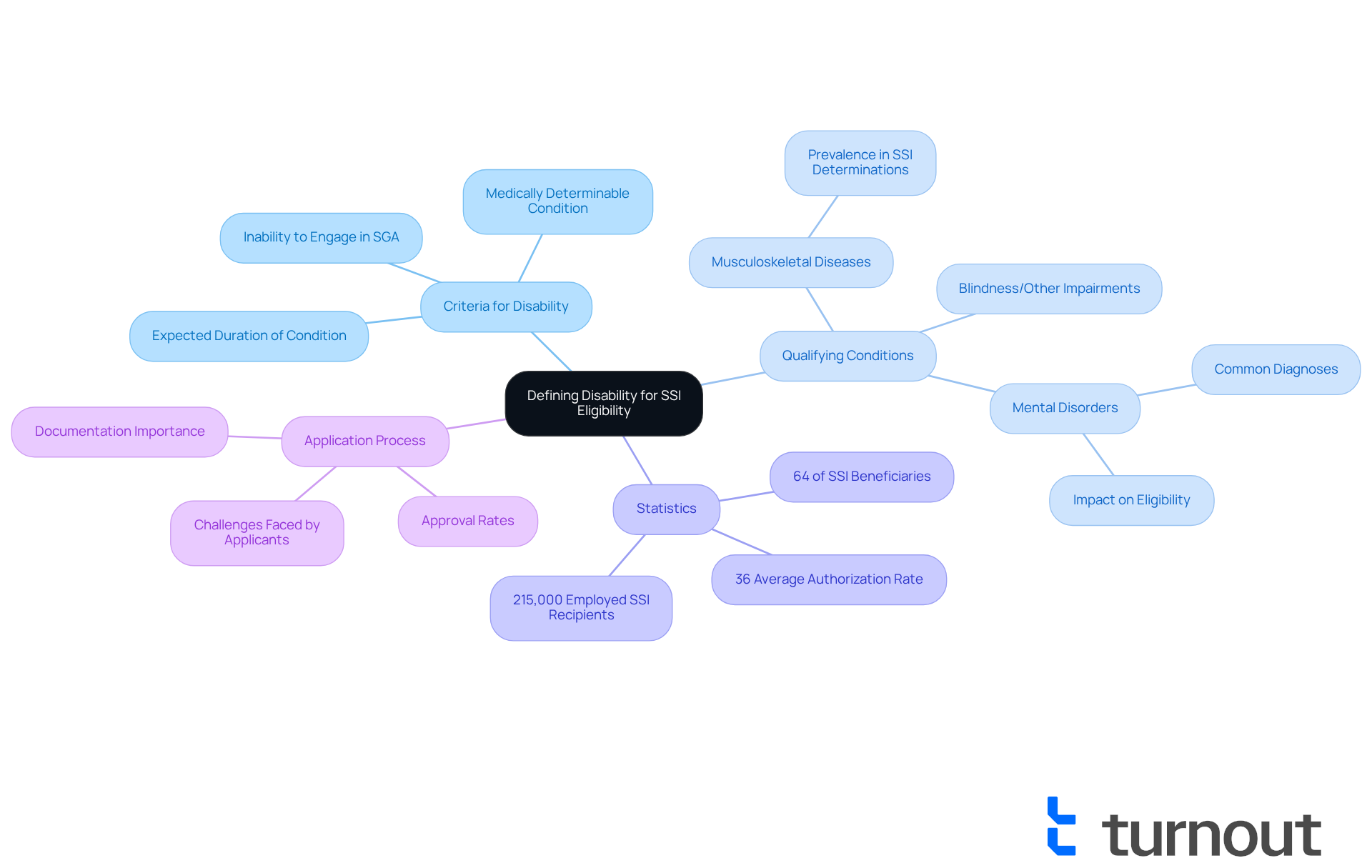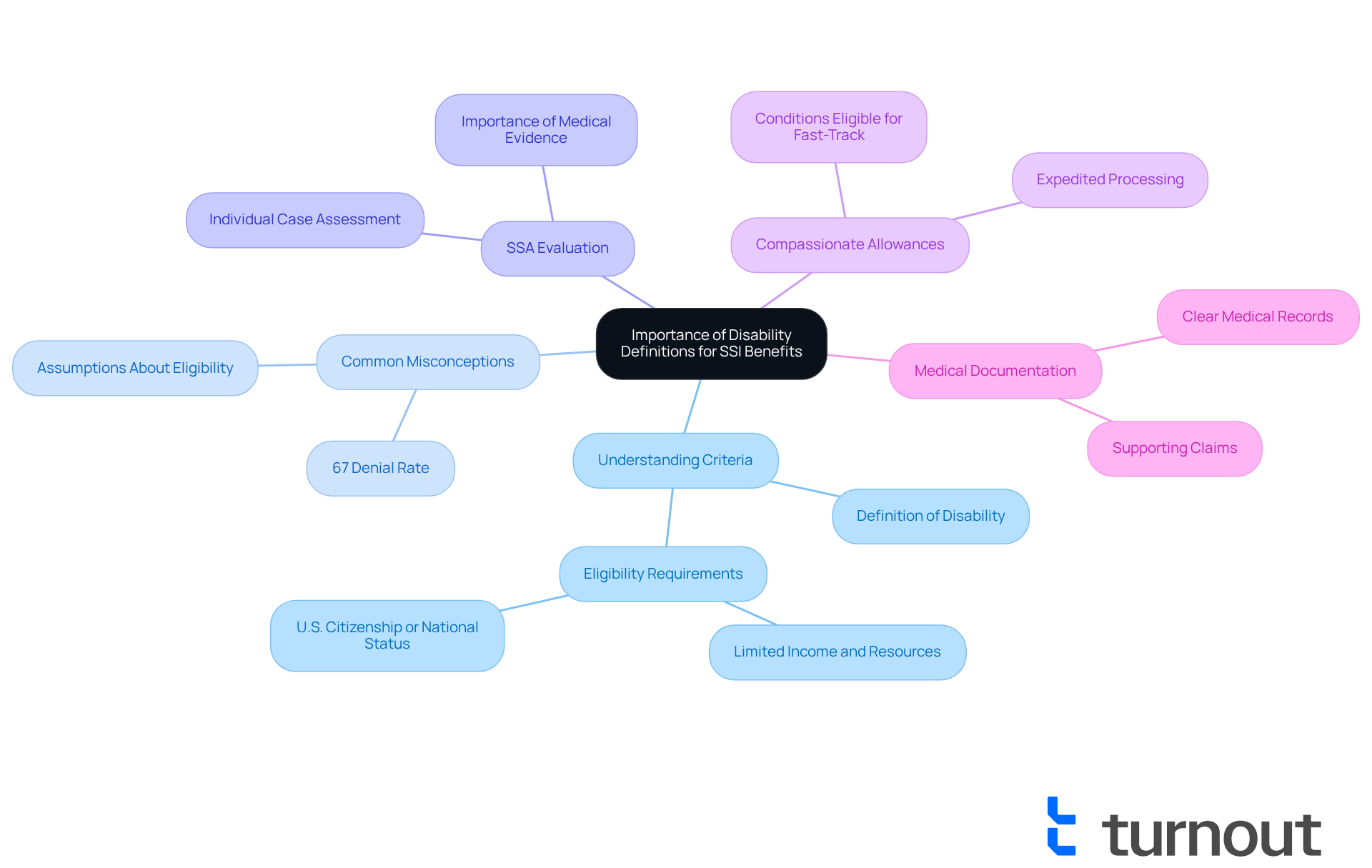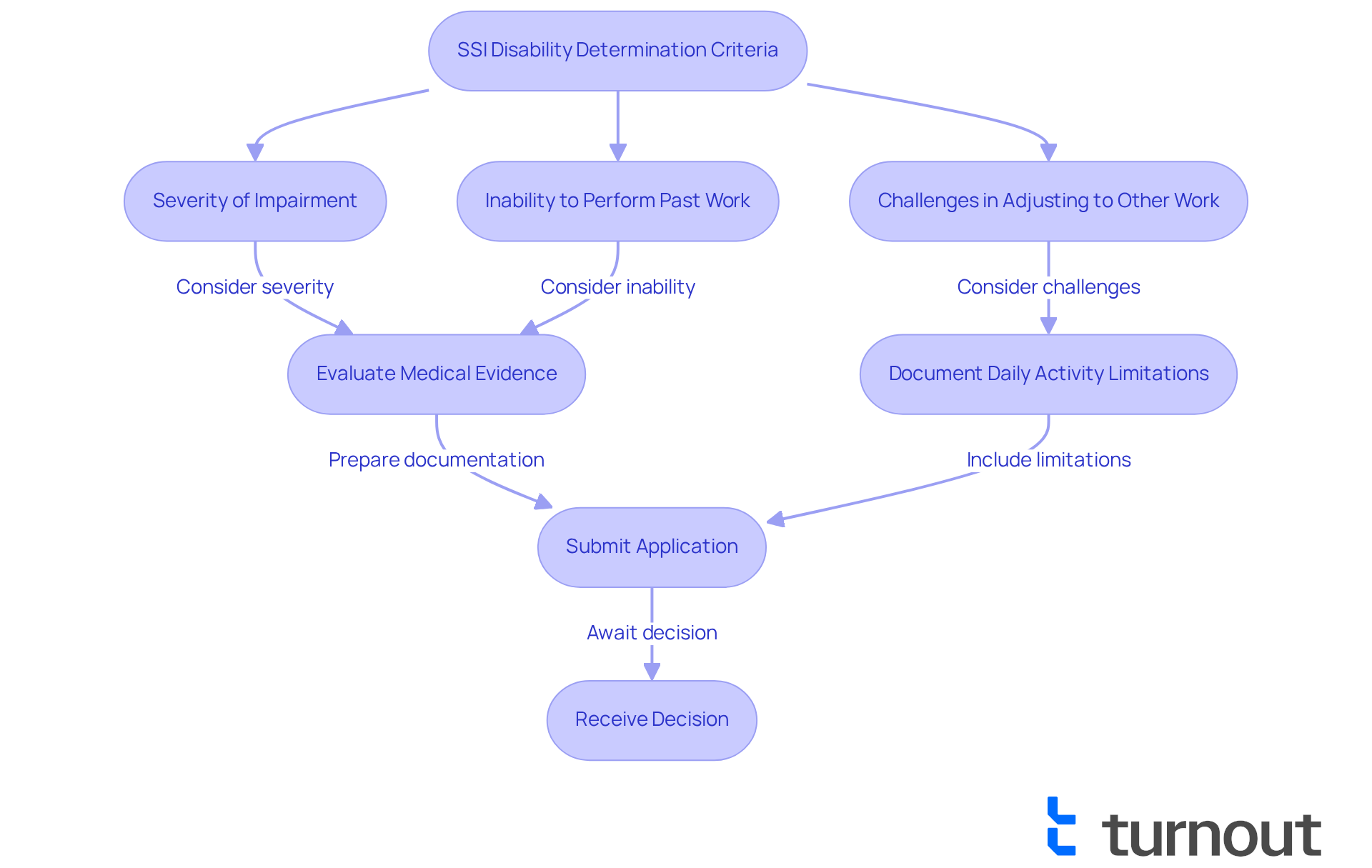Overview
Understanding disability for Supplemental Security Income (SSI) can feel overwhelming. It’s important to know that disability is defined as the inability to engage in substantial gainful activity due to a medically determinable physical or mental condition expected to last at least 12 months. This definition is not just a technicality; it’s a lifeline for many.
The Social Security Administration has specific criteria that emphasize the severity of your condition and how it impacts your ability to work. We understand that navigating these standards can be challenging. Clear documentation is crucial, and knowing what to include can make a significant difference in your application process.
You are not alone in this journey. Many have faced similar struggles, and with the right information and support, you can successfully apply for SSI. Remember, it’s common to feel uncertain about what’s required, but we’re here to help you every step of the way.
Take a moment to reflect on your situation. Are you feeling overwhelmed by the application process? It’s okay to seek assistance. With the right guidance, you can present your case effectively and increase your chances of approval.
Introduction
Understanding the nuances of disability definitions is crucial for anyone seeking Supplemental Security Income (SSI) benefits. We understand that navigating this process can feel overwhelming. The Social Security Administration (SSA) has established specific criteria to determine who qualifies as disabled, focusing on the inability to engage in substantial gainful activity due to a lasting medical condition. However, many applicants grapple with misconceptions about these definitions, leading to frustration and a high rate of initial claim denials.
What does it truly mean to be considered disabled for SSI? It’s common to feel confused and uncertain. This complexity can make it challenging to enhance your chances of approval. But you’re not alone in this journey. Together, we can explore the essential steps to help you understand the criteria and improve your application process.
Defining Disability for SSI Eligibility
In the context of Supplemental Security Income (SSI) eligibility, what is considered disabled for SSI is the inability to engage in any substantial gainful activity (SGA) due to a medically determinable physical or mental condition. This condition needs to be expected to last for at least 12 months or lead to death. The Social Security Administration (SSA) has a strict set of standards to determine if someone meets this definition, focusing on how severe the condition is and how it affects the individual's ability to work. It's important to understand what is considered disabled for SSI, as not every medical condition qualifies; the limitation must significantly hinder a person's ability to perform basic work tasks.
We understand that navigating this process can be overwhelming. In 2022, statistics revealed that musculoskeletal system diseases and mental disorders accounted for 64% of impairment determinations among SSI beneficiaries. This highlights just how common these conditions are in eligibility evaluations. Additionally, 84% of recipients qualified due to blindness or other impairments, showcasing the diverse range of qualifying conditions.
The SSA defines disability as the inability to engage in any substantial gainful activity due to one or more medically determinable physical or mental disabilities expected to last for at least 12 months. Understanding what is considered disabled for SSI is crucial for anyone seeking approval. It's common to feel uncertain, especially since the acceptance rate for SSI claims has varied, with recent assessments showing an average authorization rate of only 36%. This underscores the importance of thorough documentation and a clear understanding of how your situation aligns with SSA criteria to enhance your chances of a successful application.
It's also essential to remember that Turnout is not a law firm and does not provide legal advice. However, we’re here to help. Turnout employs trained nonlegal advocates who assist clients in navigating the complexities of SSD claims, ensuring that you feel supported in your pursuit of benefits. You are not alone in this journey.

Importance of Disability Definitions in Accessing Benefits
Understanding what is considered disabled for SSI is crucial for securing Supplemental Security Income benefits. We know that navigating this process can be overwhelming, and having a clear grasp of what is considered disabled for SSI can make all the difference. When individuals understand the specific criteria, they can present their cases more effectively, increasing their chances of approval.
It's common to feel uncertain about what is considered disabled for SSI regarding whether a condition qualifies. Many people assume their situation meets the requirements for what is considered disabled for SSI without realizing the specific limitations they need to demonstrate. This misunderstanding can lead to frustration, as nearly 67% of initial SSDI requests are denied nationwide. Only about one-third of first-time applicants receive approval for SSDI benefits.
Misconceptions about the criteria can further hinder your chances of success. The Social Security Administration (SSA) evaluates each case individually, and any condition that meets what is considered disabled for SSI can be approved. It's essential to familiarize yourself with what is considered disabled for SSI and the SSA's terms and requirements. This knowledge is vital for navigating the application process and enhancing your chances of approval.
Additionally, understanding the Compassionate Allowances program can provide a pathway for expedited processing for those with severe medical conditions. This can significantly improve your chances of timely approval. Clear medical documentation is also key to proving eligibility, as it supports the claims made in your application.
Familiarizing yourself with commonly recognized conditions, such as musculoskeletal issues and mental health conditions, can help you gauge your likelihood of qualifying for benefits. Remember, you are not alone in this journey. Turnout offers tools and services to assist individuals in navigating these complex processes. Our trained nonlawyer advocates are here to support you in your SSD claims, ensuring you have the guidance needed to present your case effectively.
We understand that this can be a challenging time, but with the right support and information, you can take confident steps toward securing the benefits you deserve.

Historical Context and Evolution of Disability Definitions
Since the creation of the Supplemental Security Income (SSI) program in 1972, we’ve seen significant changes in what is considered disabled for SSI regarding our understanding of impairment. Initially, the focus was mainly on physical conditions. However, there’s been a heartening shift towards recognizing mental health issues as what is considered disabled for SSI and how they affect a person’s ability to work.
Legislative milestones, particularly the Americans with Disabilities Act (ADA) of 1990, have played a crucial role in reshaping societal views about those with impairments. We understand that this evolution is not just about laws; it’s about people. It emphasizes a broader understanding of impairment as a complex issue that includes medical, social, and economic aspects.
As a result, the definitions of what is considered disabled for SSI have become more inclusive. They now recognize the diverse experiences of individuals facing challenges. This shift fosters a fairer approach to support and benefits, ensuring that everyone feels seen and valued.
You are not alone in this journey. We’re here to help you navigate these changes and find the support you need.

Key Characteristics and Criteria for SSI Disability Determination
Navigating the SSI application process can feel overwhelming, especially when you're dealing with a challenging condition. To qualify for SSI assistance, it's essential to demonstrate what is considered disabled for SSI, aligning with the specific standards set by the Social Security Administration (SSA). Key characteristics that determine what is considered disabled for SSI include:
- The severity of your impairment
- Your inability to perform past relevant work
- The challenges you face in adjusting to other work due to your condition
The SSA carefully evaluates medical evidence, which includes treatment records and assessments from your healthcare providers. This evaluation helps determine the extent of your disability. Additionally, you’ll need to provide documentation that illustrates how your condition limits your daily activities and capacity to work.
It's common to feel discouraged, as a significant percentage of candidates struggle to provide adequate medical evidence, which can hinder their chances of approval. Understanding what is considered disabled for SSI is crucial for anyone seeking assistance. Remember, you are not alone in this journey. We’re here to help you navigate the SSI application process successfully, especially with potential changes to eligibility assessments that could impact many applicants.

Conclusion
Understanding what constitutes a disability for Supplemental Security Income (SSI) is crucial for those seeking financial support due to their impairments. It’s about recognizing that the definition hinges on the inability to engage in substantial gainful activity because of a medically determinable condition expected to last at least 12 months. This clarity not only helps applicants navigate the often complex application process but also boosts their chances of obtaining the benefits they truly deserve.
We understand that the journey can feel overwhelming. Key points throughout this article emphasize the importance of recognizing specific criteria that define disability under SSI. Statistics show that a significant portion of SSI beneficiaries qualify due to musculoskeletal diseases and mental disorders. This highlights the variety of conditions that can be considered valid. Moreover, the historical evolution of disability definitions reflects a growing inclusivity, acknowledging both physical and mental health challenges as real impairments that impact an individual's ability to work.
Ultimately, grasping the nuances of SSI disability definitions is vital for those seeking assistance. It empowers individuals to present their cases effectively, ensuring they meet the stringent standards set by the Social Security Administration. If you’re facing the daunting SSI application process, remember that leveraging available resources and seeking support can truly make a difference. Embracing this knowledge not only fosters a sense of agency but also opens doors to the necessary benefits that can enhance your quality of life.
You are not alone in this journey. We’re here to help.
Frequently Asked Questions
What is considered disabled for Supplemental Security Income (SSI) eligibility?
For SSI eligibility, a person is considered disabled if they are unable to engage in any substantial gainful activity (SGA) due to a medically determinable physical or mental condition that is expected to last at least 12 months or lead to death.
What criteria does the Social Security Administration (SSA) use to determine disability for SSI?
The SSA uses a strict set of standards that focus on the severity of the condition and how it affects the individual's ability to work. The condition must significantly hinder a person's ability to perform basic work tasks.
What types of conditions commonly qualify for SSI disability?
In 2022, musculoskeletal system diseases and mental disorders accounted for 64% of impairment determinations among SSI beneficiaries. Additionally, 84% of recipients qualified due to blindness or other impairments, indicating a diverse range of qualifying conditions.
What is the average acceptance rate for SSI claims?
The average authorization rate for SSI claims has varied, with recent assessments showing an average acceptance rate of only 36%.
How can individuals improve their chances of a successful SSI application?
To enhance the chances of a successful application, it is important to provide thorough documentation and have a clear understanding of how one's situation aligns with SSA criteria.
Does Turnout provide legal advice for SSI claims?
No, Turnout is not a law firm and does not provide legal advice. However, they employ trained nonlegal advocates who assist clients in navigating the complexities of SSD claims.




